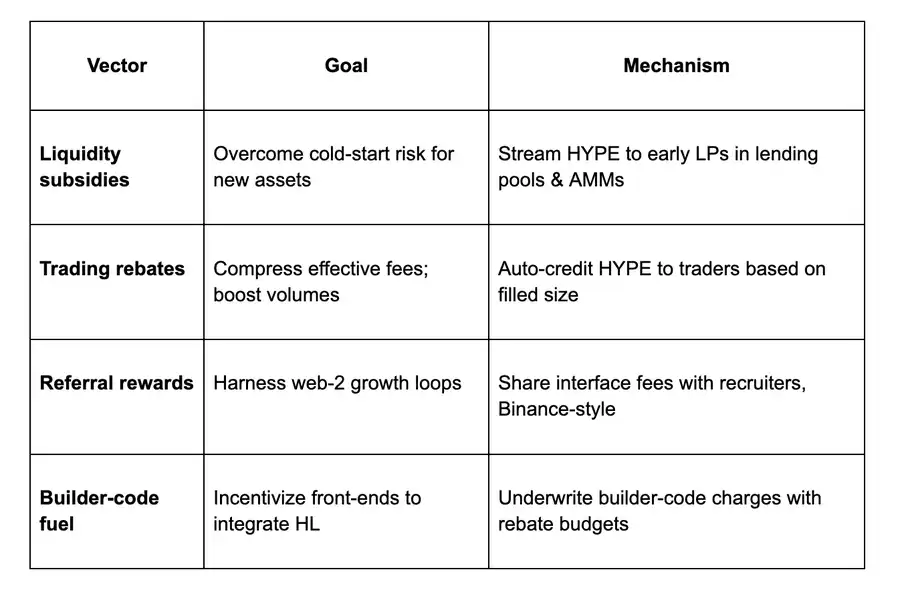Original Title: What does it mean to be a Hyperliquid-aligned fiat stable?
Original Author @husd_fiat
Original Translation: zhouzhou, BlockBeats
Editor's Note: HUSD is a public stablecoin project launched by Hyperliquid, which channels stablecoin interest back into the ecosystem for repurchasing HYPE, subsidizing interface fees, supporting the Builder Code model, and promoting ecosystem growth. It breaks the USDC/Tether model, redirecting funds away from centralized institutions and back into community and product development.
The following is the original content (reorganized for better readability):
What the Ecosystem Truly Needs
The story of HUSD is about how to disrupt a multi-billion dollar stablecoin market. Hyperliquid initially emerged as a leading perpetual contract decentralized exchange (perp DEX), outperforming older players like DYDX and GMX. As the product continues to attract new users and gradually introduces spot markets, Hyperliquid is evolving into a competitor to Binance/Coinbase. The next target for the ecosystem is the duopoly of fiat stablecoins—Circle and Tether.
Currently, approximately $2.5 billion of cross-chain USDC is locked in HyperCore's order book, earning about 4.3% interest. This revenue can generate around $107.5 million annually for Circle Internet Financial, flowing into its private balance sheet. Every new deposit of USDC into Hyperliquid further expands Circle's cash flow. But what if this value did not flow to Circle, but instead was used to strengthen the Hyperliquid ecosystem? Why should we remain bound by the outdated traditional stablecoin model of USDC when we have the opportunity to break free from the existing framework?
The Opportunity Cost of Continuing with Old Stablecoins

As Hyperliquid's influence in on-chain trading continues to grow, net deposits of fiat stablecoins also increase, providing liquidity for the perpetual contract and spot markets. In a future where Hyperliquid grows 10x, 100x, or even 1000x, the opportunity cost of continuing to use traditional stablecoins will also rise. The value from the stablecoin layer will either continue to flow into Circle and Tether's balance sheets or be redirected back into Hyperliquid's own ecosystem.
A New Stablecoin Model Tailored for Hyperliquid
The "Assistance Fund" has proven that the cash flow generated by the protocol can and should be directly returned to the community through automatic repurchases of HYPE. In just the past 30 days, the Assistance Fund has reclaimed millions of dollars in HYPE from the market.
HUSD continues this strategy, but it operates at the stablecoin level: initially, a significant portion of the interest income generated by HUSD will be used to purchase HYPE, which will then be deployed across various growth directions within the Hyperliquid ecosystem. In other words, every time you use HUSD, it will increase buying pressure for HYPE and reinvest value back into the development of Hyperliquid.
How Will the Repurchased HYPE Be Used?

HUSD: Fueling the Future of Builder Code
HUSD plays a key role in driving the explosion of the "Builder Code" business model. Builder Code is Hyperliquid's native feature that allows an interface operator to charge a fee for spot or contract trades submitted on behalf of users. Its goal is to provide a monetization method for Hyperliquid's "last mile distribution"—meaning anyone who can effectively attract and retain users can establish a trading business without technical or liquidity constraints through Builder Code.
The unit economics of such businesses can be quite substantial, but at this early stage, new brands still face "cold start" issues, and the competitive moat between different interfaces is not yet clear. The emergence of HUSD can help these "Hyperliquid hybrids" complete their launch while providing a way for them to differentiate themselves.
By subsidizing the fees for Builder Code with HUSD, interfaces can charge users higher fees without increasing their costs. Interfaces can earn revenue in real-time and further use those funds for growth strategies.
For example: Suppose Interface XYZ has a rebate budget of 100 HUSD. All contract trades with its Builder Code will be tracked by the system, and the corresponding user's rebate balance will continue to grow. Before users actually start incurring costs, the interface can handle approximately $100,000 in contract trading volume (i.e., 100 HUSD divided by a 0.1% fee rate). Meanwhile, the interface operator can reinvest the income generated by Builder Code into user acquisition or retention.
This is how HUSD powers "real-time growth" for the Hyperliquid ecosystem.
Conclusion
HUSD integrates two core insights: unifying the pricing asset (stablecoin) used for trading and the cash flow it generates within the trading platform system. The end result is a stablecoin with the nature of a "public product," transforming the previously static reserve interest into proactive, compound growth for the Hyperliquid ecosystem.
HUSD is a public product project operated by Felix and supported by community members, which will be launched through the Felix Points system. This deployment is also built on the foundation laid by @m0foundation, whose vision for a "global stablecoin platform" has made HUSD possible.
Hyperliquid has already disrupted the landscape of centralized exchanges, and HUSD is preparing to do the same to traditional fiat stablecoins.
免责声明:本文章仅代表作者个人观点,不代表本平台的立场和观点。本文章仅供信息分享,不构成对任何人的任何投资建议。用户与作者之间的任何争议,与本平台无关。如网页中刊载的文章或图片涉及侵权,请提供相关的权利证明和身份证明发送邮件到support@aicoin.com,本平台相关工作人员将会进行核查。



